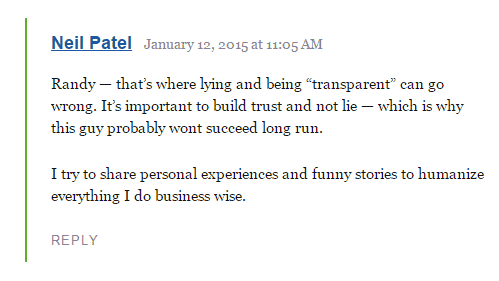Last week, we talked about the definition of engagement—being so “in sync” with your followers that you consistently deliver value and delight your audience.
The key is this: Your customers—not you—do the measuring.
We’re now at a point where content marketing is an accepted part of the marketing plan. Trouble is, most brands define success as having a blog and publishing on a semi-regular basis.
They’re not worried about creating better content because they’re still worried about creating it at all.
It makes sense. Any time you do something new, you have to put a lot of focus on what you’re doing and how you do it: Where do you get your ideas? Does someone need to approve them? What’s the timeline for writing and editing? Etc. Etc. Etc.
For beginners, optimization is about improving the process, not getting better results.
It’s time to take it to the next level: Stop navel gazing and start engaging. What I mean is this…
Hopefully, by now you’ve figured out how to write a better blog post. It’s time to figure out what type of posts your audience loves, so you can create bigger wins more often.
Does it matter?
You bet. Both internally and externally, engagement has a positive impact on your success.
According to Gallup, “engaged employees create engaged customers,” which creates “greater financial outcomes.”
What is that outcome?
On average, an engaged customer generates 1.7 times more revenue than the typical customer.
Also, according to Gartner, “engaged customers are more loyal, better advocates, and more likely to provide feedback and suggestions.”
Based on the research, I’d say engagement should be your number-one goal for content marketing.
Why engagement is so hard
As we’ve discussed in previous articles, engagement is ridiculously hard to measure, because there’s no one metric that tells you whether you’re hitting the mark.
That said, there are some brands that are looking at their numbers and making some smart assumptions. All of them, in their own way, are nailing engagement.
These are the brands I’m evaluating today: QuickSprout, Conversion Scientist, and HubSpot. Let’s take a look at what they’re doing well, and what you can learn from them.
QuickSprout
This is one of Neil Patel’s blogs, and it has quickly become a leader in the digital marketing space. Core topics are traffic and conversion, but Neil talks about anything marketing-related that has caught his or his audience’s eye.
What he’s doing right
- Being human and accessible
- Providing relevant, actionable advice people can trust
- Getting his audience to respond
My evaluation
As business blogs go, this is an interesting one. Based on what I see, I assume these are the goals for the blog:
- generating leads for Neil’s consulting business
- establishing Neil’s expertise and enlarging his personal brand
- testing new marketing strategies for future articles and consulting gigs
From my perspective, he does all of this especially well. I’d rank QuickSprout as one of the top blogs for engagement.
For example, an article from January 2015 now has 356 Facebook shares, 1.1K tweets, and 161 Google+ shares. It also has approximately 80 comments.
How does Neil get those numbers?
The real strength of Neil’s strategy is his willingness to give an inside look at what’s working, so his readers don’t have to guess.
There’s a movement toward transparency in business blogs—but that’s not what this is. Neil is simply honest about who he is, his mistakes and his successes. Then he translates those experiences into actionable tips his followers can use.
This builds trust, which keeps people engaged. Here’s how Neil expressed it in a comment on one of his blog posts.
Neil is, above all else, authentic, which makes him very credible. It also helps him show rather than tell, which adds a lot of value to his content.
How you can do it too
First, be yourself.
Second, do the extra work to provide quality information people can trust. Don’t just talk about a topic. Find statistics and case studies to back up your claims. Then tell readers what to do next, so they get quick wins after reading your content.
Conversion Scientist
If you’re looking for a conversion rate optimization (CRO) agency, you need to seriously consider ConversionSciences.
If you’re more of a do-it-yourselfer or want to learn CRO, you need to read Your Customer Creation Equation, by Brian Massey, the head Conversion Scientist.
And if you want to see how a business in a potentially dull space creates engaging content, you should follow the ConversionScientist (CS) blog.
What they’re doing right
- Finding delightful ideas to blog about
- Sharing truly useful ideas and tips
- Creating an elite club around being a numbers nerd
My evaluation
Engagement is about knowing your readers and giving them the information they need—while also, hopefully, delighting them.
Personally, I’m delighted by cleverness—a trait I see a lot in Brian’s content.
I love how Conversion Sciences leverages science, not just to strengthen the brand but to make conversion optimization more understandable to the average marketer.
The lab coat is a big win for me. As is the “Periodic Table” of conversion elements, which Brian used in last week’s ConversionWorld presentation. (Way to go, Brian!)
But the cleverness doesn’t stop there.
I’ve had the pleasure of working with Brian on a few of his projects, so I can personally attest to the energy his team puts into creating delightful experiences. The “Conversion Capital of the World” blog series is a great example.
Apparently, Brian had been talking with his conversion buddies at a summit in Austin, Texas, and they decided that there was such a great CRO presence in the city, it could easily be called the Conversion Capital of the World.
For most of us, a conversation like that would end after the summit. But Brian recognized a big idea and ran with it.
In early 2014, he asked me to contact Austin CRO experts, interview them, and write a feature for his blog.
It made waves in the CRO community, because on February 7, Canadian CROs wrote a rebuttal, which Brian posted on his blog.
Then this year, he asked me to write a follow-up article, proving Austin’s continued claim to the Conversion Capital title.
Can you see what he’s doing here?
He’s tapping into conversations that are taking placing in the industry and creating entertaining content around them. He’s also building up the community and helping people feel like they’re part of something big.
Better still, he’s doing it in a way that builds his brand. This excerpt from the CS blog sums it up nicely:
Content Marketing is one reason we have enjoyed so much success, and our blog is the heart of our content marketing efforts. We take it very seriously.
We want posts that are popular to our target audience, marketers struggling to use data and testing wisely in their online efforts. We also want content that grows our subscriber lists. This is how we begin a relationship with you, our readers.
Like most of us, Conversion Scientist has more than one goal. Where they differ is in giving “popular” posts a high priority. But their plan is solid.
Popularity is a good measure of engagement, and engagement, as research proves, is what fuels your profits.
How you can do it too
First, don’t focus solely on writing about your products or methodologies. Write content that people enjoy reading. Just make sure it also makes them want to subscribe.
Second, create content that builds community and a sense of belonging. This will make you a leader in your space, which will result in name recognition and credibility.
HubSpot
 When it comes to inbound marketing, HubSpot set the standard (the above image is just one example). They’re masters at figuring out what their audience struggles with and creating content to give them answers.
When it comes to inbound marketing, HubSpot set the standard (the above image is just one example). They’re masters at figuring out what their audience struggles with and creating content to give them answers.
What they’re doing right
- Giving readers quick wins
- Keeping readers updated on trending ideas
- Downloads for free resources
My evaluation
I’ve been following HubSpot since 2010, and I’ve kept an eye on changes in their marketing and engagement tactics. In the last year or two, it looked like they were testing unusual engagement factors, such as magazine-style headlines and categories of content.
But as their style has evolved, one thing remains constant: HubSpot’s dedication to providing useful information and downloads for their readers.
If I’m honest, that’s how they got on my radar in the first place. When I wanted to learn more about XYZ, they had an ebook on it.
It may seem pushy to make a ton of offers or put all your content behind an optin gate, but nothing could be further from the truth. If the information is consistently good, you’ll develop a loyal following.
How you can do it too
Focus on providing value. Get to know your audience, and look for ways you can help them achieve their goals.
Create tons of valuable downloads. This helps you build your list while keeping the focus on your audience.
Just make sure you keep the quality high.
Bottom line
Selecting just 3 brands to feature in this article was tough. I follow a lot of blogs that are masters of engagement.
But these three brands stand out for doing content right. They’re all paying attention to their followers and testing new strategies. And for them, continuous improvement is part of the process.
Their real secret, though, is their focus on engagement. To succeed in content marketing, you have to start there.
What’s your favorite engagement tactic? Do you know of a business brand that’s doing it well?





